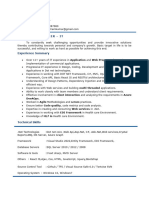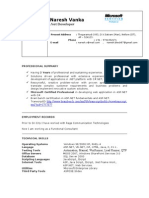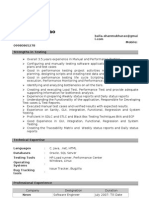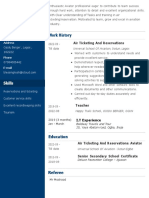Codeforces
Codeforces
Uploaded by
Old GamingCopyright:
Available Formats
Codeforces
Codeforces
Uploaded by
Old GamingOriginal Description:
Original Title
Copyright
Available Formats
Share this document
Did you find this document useful?
Is this content inappropriate?
Copyright:
Available Formats
Codeforces
Codeforces
Uploaded by
Old GamingCopyright:
Available Formats
Code Forces Rating Predictor
Satvik Ramaprasad Raghavan G V Ananth Shreekumar
satviksunkam.ramaprasad@iiitb.org raghavan.gv@iiitb.org ananth.shreekumar@iiitb.org
IMT2016008 IMT2016099 IMT2016129
Abstract—Competitive Programming is a mind sport II. DATASET
where programmers are expected to solve challenging
problems in a given timeframe. It is known for involving Since this is a new problem, there was no dataset
problem statements that require creative thinking on the available which captured all the necessity “features”. We
part of the programmers. Competitive programmers are had to generate our own dataset using a combination
tested on their months of hard work and persistence, of the APIs provided by Codeforces and scraping some
alongside their ability to solve a problem and build a code.
pages of their website. Given the time consuming nature
This sport has been gaining popularity across the students
of crawling/scraping, we decided to first select data
of India since half a decade
This paper is a report on a project that was conducted attributes from which we can extract features.
to predict a user’s rating on Code Forces - A Competitive
Programming Platform - using concepts from Machine A. User Dataset
Learning. We propose to create a model that will predict
a user’s rating based on the problems that he has solved. Using Codeforces API, we obtained raw user data of
We solve two problems - given a user’s data, predict his all users on the platform. There were a total of 158K
maximum rating using regression approaches, and given a users from several countries. Given the time constraint,
user’s data, predict his rank using classification techniques. we decided to restrict ourselves to Indian users. Upon
Rank is determined by his rating. filtering, we obtained a total of 11.5K Indian users.
I. I NTRODUCTION We grouped users based on their organization. The total
number of organizations turned out to be 959. We again
Programming is one the most sought-after skills in the filtered only on organizations which had more than 20
World today. However, a good programmer must also users. After all the filters, the dataset was reduced to 83
know algorithms to solve problems and to come up with organizations and 6.4K users.
his own algorithms for an efficient solution.
Code Forces is a website where people can sign up Data attributes collected
and hone their skills in programming and algorithms in • Country
a language of their choice. The submitted solutions are • Organization
run through a set of test cases to check their correctness. • Handle
Codeforces also conducts weekly contests, during which • Timestamp of user creation
the contestants are expected to code up a solution to • Contributions
the given problems. The programmer’s rating is affected • Number of Friends
based on criteria - the number of problems solved, • Rating
the time taken to solve, and the number of wrong • Max Rating
submissions for a problem during the contest. • Rank
In this paper, we also present a novel approach on B. User - Submissions Dataset
using the information about the quantity and quality of
the problems that he has practiced all along and we want Using Codeforces API, we obtained the total list of
to predict the current rating of the user. submissions by the user. This was used to perform a
join between each user and problem submission data.
By doing this we give users a vague prediction of what This was crucial to aggregate and extract features from
his / her current rating will be according to her practice. the submission data.
C. Problem Dataset
Using Codeforces API, we obtained raw problem data
of all problems on the platform. There were a total of
4637 problems with varying difficulties. Since difficulty
level of the problems were not provided by the API, we
had to scrape it from the website.
Data attributes collected
• contestId
• index
• name
• type
• tags
• Difficulty
III. F EATURE E NGINEERING
We performed a join on the user submission data and
problem data based on problem id. We then performed
statistical aggregation on the result.
We computed the mean, median and the mean of the
top 20% of the problem’s difficulty solved by the user.
The total number of problems solved successfully was
also extracted as a feature.
We classified problems into buckets based on their dif-
ficulty score and performed a count. We further classified
problems based on their problem tags and performed a
count.
Data Features Extracted A. Rating Predictor
• avg difficulty Rating prediction is a regression problem. We built
• avg difficulty20 Linear Regression, Random Forest and XG Boost clas-
• median difficulty sifiers on the dataset.
• duration
B. Rank Predictor
• tags (set)
Rank prediction is a classification problem. We built
• difficulty buckets (set)
Logistic Regression, Random Forest and XG Boost clas-
• problem count
sifiers on the dataset.
• contest count
VI. R ESULTS AND A NALYSIS
IV. DATA V ISUALISATION
A. Rating Predictor
One of the major consequences of this project was
that we could empirically prove that a person generally Since rating prediction is a regression problem, we
has a higher rating if he has solved more problems than used R2 score and RMS Error as our metric. XGBoost
his peers. We plotted the rating alongside the number of algorithm gave our best score with a R2 score of 0.82
problems solved for the users in the dataset to achieve and RMS Error of 75.11. Codeforces on an average gives
this. around −100 to +100 rating change to a contestant after
every contest based on relative performance. Since our
V. M ODELS AND T RAINING RMS Error is around 75 points we could certainly tell
We tried multiple models to get an idea of which that we are only one or two contests behind the actual
performs better. rating of the user.
VIII. F UTURE S COPE
1. All the countries in the World could be included to
obtain a better dataset to build a model.
2. We could try to predict a user’s rating sometime in
the future if he continues at the same level of effort.
ACKNOWLEDGMENT
The authors would like to thank professors for their
continued guidance, support and encouragement. Further
the authors would like to thank the teaching assistants
for their valuable advice and encouragement.
R EFERENCES
[1] Codeforces api documentation. [Online]. Available:
https://codeforces.com/api/help
[2] “Scikit-learn documentation.” [Online]. Available: http://scikit-
learn.org/stable/documentation.html
[3] “Pandas documentation.” [Online]. Available:
https://pandas.pydata.org/pandas-docs/stable/
[4] “Numpy documentation.” [Online]. Available:
https://docs.scipy.org/doc/
[5] “Xgboost documentation.” [Online]. Available:
https://xgboost.readthedocs.io/en/latest/
[6] “Xgboost documentation.” [Online]. Available:
https://readthedocs.org/projects/beautiful-soup-4/
B. Rank Predictor
Rank prediction is classification problem where the
rank of the given user is predicted. As we clearly can
see that predicting a user as ’expert’ (category - 4) when
he is ’candidate master’ (category - 5) is not a very bad
result as they both are very close to each other in the
ranking graph. But since the model considers these both
as completely independent categories we won’t be able
to get a good classification. The best score that we could
get was using logistic regression which gave us the mean
score of 0.604.
VII. I SSUES FACED
Data collection turned out to be tricky and time
consuming. Network issues slowed down our data crawl-
ing. Moreover codeforces blocked our IP addresses for
repeated requests. We resorted to using VPNs to get
through the restriction. We also tried parallizing our
requests using multiple threads to speed up the process.
You might also like
- Machine Learning PPT For StudentsDocument18 pagesMachine Learning PPT For Studentsrajesh75% (8)
- Re Level Course BrochureDocument18 pagesRe Level Course BrochureHuneshwar Kumar YadavNo ratings yet
- 2018 English Reviewer - 130 Questions With Answers - LET EXAM - Questions AnswersDocument8 pages2018 English Reviewer - 130 Questions With Answers - LET EXAM - Questions AnswersJong FrancoNo ratings yet
- Sedona Method QuestionsDocument6 pagesSedona Method QuestionsKimBond90% (10)
- Annotated Bibliography ExampleDocument5 pagesAnnotated Bibliography ExampleVincent AyagaNo ratings yet
- Mohity UpdatedDocument2 pagesMohity UpdatedMohit JainNo ratings yet
- BT4344 PPTDocument16 pagesBT4344 PPTrishav.scsebtechNo ratings yet
- Gayatri Resume Update 2Document2 pagesGayatri Resume Update 2sidharthgaikwad244No ratings yet
- Naukri ThorthiNaveen (5y 6m)Document5 pagesNaukri ThorthiNaveen (5y 6m)hmore1998No ratings yet
- Advanced Certification Exam Prep GuideDocument21 pagesAdvanced Certification Exam Prep Guidesimha1177No ratings yet
- Experienced Testing Resume Model 172Document4 pagesExperienced Testing Resume Model 172api-3732800100% (1)
- Re 1.5 Exp 23Document3 pagesRe 1.5 Exp 23Hko KumarNo ratings yet
- Adarsh SharmaDocument4 pagesAdarsh Sharmasumit kumarNo ratings yet
- RadhikaKhandelwal (3 0)Document2 pagesRadhikaKhandelwal (3 0)harshiniguttiNo ratings yet
- Rantejbir Singh-ResumeDocument3 pagesRantejbir Singh-Resumedandamudi.ramyaNo ratings yet
- Sandeep - Mishra - Resume 1Document3 pagesSandeep - Mishra - Resume 1CHIRAG DASHNo ratings yet
- Re Level Course BrochureDocument18 pagesRe Level Course Brochureabhishek kumar100% (1)
- Rajeswara ReddyDocument5 pagesRajeswara ReddySudheerNo ratings yet
- Sambasivarao Ravipati PH: Sr. Etl Bigdata Qa Consultant EmailidDocument7 pagesSambasivarao Ravipati PH: Sr. Etl Bigdata Qa Consultant Emailidraju chNo ratings yet
- Designation: SQA Engineer Phone No: +91-9490315199 ObjectiveDocument5 pagesDesignation: SQA Engineer Phone No: +91-9490315199 ObjectiveRaaju LenkaNo ratings yet
- Venkat ResumeDocument3 pagesVenkat ResumeEswar KumarNo ratings yet
- Online ExaminationDocument21 pagesOnline Examinationravan rajNo ratings yet
- Ramana Resume PDFDocument5 pagesRamana Resume PDFNarendra DusanapudiNo ratings yet
- Resume Format 3Document3 pagesResume Format 3Chaluvadi LaxmanNo ratings yet
- Alekya ResumeDocument4 pagesAlekya Resumemanoj kotaNo ratings yet
- Madhukar Jain (Singapore PR Holder) (ISTQB Certified Software Test Engineer)Document5 pagesMadhukar Jain (Singapore PR Holder) (ISTQB Certified Software Test Engineer)api-3760577No ratings yet
- Resume Format 3Document3 pagesResume Format 3thrinadh vunnamNo ratings yet
- PG Certification in Data Science & AI Hyd - EdvancerDocument14 pagesPG Certification in Data Science & AI Hyd - Edvancerdwaraka mayeeNo ratings yet
- Accenture Toolkit 1Document14 pagesAccenture Toolkit 1Srija MalaeNo ratings yet
- OPI Rishna Omanduri: Profile OverviewDocument5 pagesOPI Rishna Omanduri: Profile OverviewGopi KomanduriNo ratings yet
- Quiz ProjectDocument30 pagesQuiz ProjectRohit MishraNo ratings yet
- Pawan PatidarDocument5 pagesPawan Patidarmiss_jyoti_kapoorNo ratings yet
- Raj Bansal Resume PDFDocument1 pageRaj Bansal Resume PDFSree Ramu KarlapatiNo ratings yet
- LEC 1 IntroductionDocument57 pagesLEC 1 Introductiondemro channelNo ratings yet
- Quiz Contest A Quiz Application A PROJECDocument45 pagesQuiz Contest A Quiz Application A PROJECApurva MotghareNo ratings yet
- Career Objective:: Dhamodharan J Mob: No: 9952424967Document6 pagesCareer Objective:: Dhamodharan J Mob: No: 9952424967Rohit RaiNo ratings yet
- Senior Software Engineer Web Api 11Document7 pagesSenior Software Engineer Web Api 11Ram KumarNo ratings yet
- Preeti S Panchagavi-2years Exp ResumeDocument4 pagesPreeti S Panchagavi-2years Exp ResumePreeti PanchagaviNo ratings yet
- Amrit Das ResumeDocument6 pagesAmrit Das Resumepritesh hansaNo ratings yet
- Chandra Sreenivasulu Mobile: 9606191854: BjectiveDocument4 pagesChandra Sreenivasulu Mobile: 9606191854: BjectiveKavithaNo ratings yet
- Vivek Chaurasia - CVDocument4 pagesVivek Chaurasia - CVSujeet kumarNo ratings yet
- Naresh ResumeDocument8 pagesNaresh ResumeettiguntaNo ratings yet
- Mohanraj Resume 2019Document4 pagesMohanraj Resume 2019johohiNo ratings yet
- Charan Kumar: It SkillsDocument3 pagesCharan Kumar: It SkillsVivek PaulNo ratings yet
- Manual Testing 2 Years ExpDocument4 pagesManual Testing 2 Years ExpTest QANo ratings yet
- Resume23 1Document1 pageResume23 1Evan RaisulNo ratings yet
- Kendriya Vidyalaya Iit-Kanpur: Grade CalculatorDocument30 pagesKendriya Vidyalaya Iit-Kanpur: Grade CalculatorkartikNo ratings yet
- Jivraj Singh: Serenity FrameworksDocument3 pagesJivraj Singh: Serenity FrameworksBhupendra SinghNo ratings yet
- Java Full Stack 2.0: Introduction To JAVA Day - 1Document265 pagesJava Full Stack 2.0: Introduction To JAVA Day - 1SavitaDarekarNo ratings yet
- RohitashY - UI Automation - MS 4.5yrDocument4 pagesRohitashY - UI Automation - MS 4.5yrrakeshmishra5077No ratings yet
- Soumen Banerjee CVDocument3 pagesSoumen Banerjee CVSoumen BanerjeeNo ratings yet
- Naukri SRKPrasad (7y 0m)Document5 pagesNaukri SRKPrasad (7y 0m)aravind563No ratings yet
- Pransu Jain ResumeDocument1 pagePransu Jain ResumepriyasNo ratings yet
- Gundu Sravan Kumar - ServiceNowDocument4 pagesGundu Sravan Kumar - ServiceNowRavi Teja deeviNo ratings yet
- Jitesh Gupta Resume 2021Document1 pageJitesh Gupta Resume 2021CHINMAY MULAYNo ratings yet
- Vikash Tiwary: Programmer Analyst (Full Stack Developer)Document7 pagesVikash Tiwary: Programmer Analyst (Full Stack Developer)VikashNo ratings yet
- Shanmukha Rao: Balla - Shanmukharao@gmai Mobile: 09980865278 Strengths in TestingDocument5 pagesShanmukha Rao: Balla - Shanmukharao@gmai Mobile: 09980865278 Strengths in Testingkethireddy2010No ratings yet
- Cucumber NotesDocument18 pagesCucumber Notesvingale96No ratings yet
- Resume Pratik Jhalora FullStack 2023Document4 pagesResume Pratik Jhalora FullStack 2023Shalender KundnaniNo ratings yet
- (Solved) Final Report Outlining The Following Tasks - Task 1 - Using Tableau... - Course HeroDocument5 pages(Solved) Final Report Outlining The Following Tasks - Task 1 - Using Tableau... - Course Heroziniaafrin1988No ratings yet
- Siddhartha Das ResumeDocument1 pageSiddhartha Das ResumeAmarjeet SinhaNo ratings yet
- My ResumeDocument5 pagesMy Resumenarasinga.rao100% (2)
- Scalable Data Architecture with Java: Build efficient enterprise-grade data architecting solutions using JavaFrom EverandScalable Data Architecture with Java: Build efficient enterprise-grade data architecting solutions using JavaNo ratings yet
- Satir Change ModelDocument9 pagesSatir Change ModelWalter Macuada100% (1)
- Perception, Perceptual Process, Principles of PerceptionDocument15 pagesPerception, Perceptual Process, Principles of PerceptionshaimaNo ratings yet
- Frayer Model ChronolgyDocument3 pagesFrayer Model ChronolgyJoshua David MathewsNo ratings yet
- IppdDocument133 pagesIppdPonggey YabolNo ratings yet
- Techniques To Better MemorisationDocument2 pagesTechniques To Better MemorisationDR BaoucheNo ratings yet
- Ed 478 Lesson Plan Feb 25 26 2014Document2 pagesEd 478 Lesson Plan Feb 25 26 2014api-249542154No ratings yet
- 1st Group SLA TBI-DDocument5 pages1st Group SLA TBI-Drosi yantiNo ratings yet
- Grade 8-Curriculum Evaluation FormDocument13 pagesGrade 8-Curriculum Evaluation Formmarl Jay JABILLONo ratings yet
- Grade 7 SF1 OFFICIALDocument25 pagesGrade 7 SF1 OFFICIALPeterClomaJr.No ratings yet
- Edu 202 - Model of Effective InstructionDocument5 pagesEdu 202 - Model of Effective Instructionapi-515038902No ratings yet
- SCAT RevisedDocument3 pagesSCAT RevisedDigantika MaityNo ratings yet
- Error AnalysisDocument18 pagesError Analysissubbanna ch100% (1)
- Nyaya School of PhilosophyDocument9 pagesNyaya School of PhilosophyShivamNo ratings yet
- DLL Week 5 Grade 11 PEDocument2 pagesDLL Week 5 Grade 11 PEadriene09No ratings yet
- RPH34 SN T2 EngDocument3 pagesRPH34 SN T2 Engnorliza hadamanNo ratings yet
- Hindi Intent ClassificationDocument12 pagesHindi Intent ClassificationSathvick Batchu100% (1)
- Pedagogical Approachesin Teaching MAPEHDocument15 pagesPedagogical Approachesin Teaching MAPEHEhya AbetriaNo ratings yet
- 3362-Article Text-8040-2-10-20230612Document9 pages3362-Article Text-8040-2-10-20230612s7451638No ratings yet
- How To Synthesize Written Information From Multiple SourcesDocument7 pagesHow To Synthesize Written Information From Multiple SourcesHarriet Kirkland100% (2)
- Vesela Mih Thesis SMDocument102 pagesVesela Mih Thesis SMJohnNo ratings yet
- Tarullo, Obradovic, Gunnar (2009, 0-3) Self-Control and The Developing BrainDocument7 pagesTarullo, Obradovic, Gunnar (2009, 0-3) Self-Control and The Developing BraingratzybahNo ratings yet
- Notice WritingDocument14 pagesNotice Writingadi rajNo ratings yet
- Free Will Scandal PDFDocument482 pagesFree Will Scandal PDFChris WalkerNo ratings yet
- Lesson 1 (Philosophical Self)Document5 pagesLesson 1 (Philosophical Self)Mariane EsporlasNo ratings yet
- An Introduction To The Theory of Computation (1989 Gurari)Document601 pagesAn Introduction To The Theory of Computation (1989 Gurari)Andre McDermottNo ratings yet
- Blessing Ezenwa Resume 2-1Document1 pageBlessing Ezenwa Resume 2-1DavidNo ratings yet

























































































